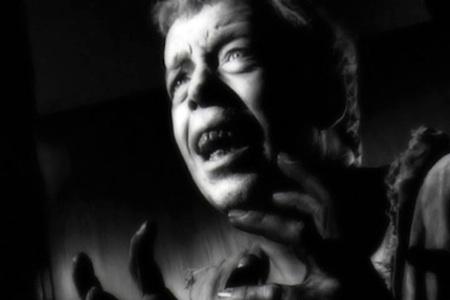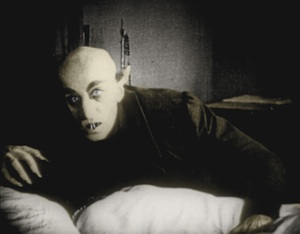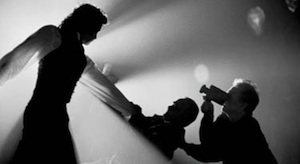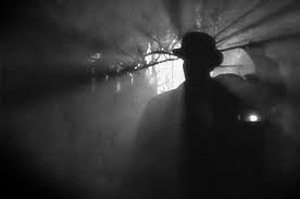Because it’s so many things to so many people, cinema is filthy with secret histories, now more than ever thanks to the ease and cheapness of digital moviemaking and online distribution. Let’s dally over one such neglected backroad, only because we find it beautiful in a defiant way: the retro-film, the movies occasionally crafted to self-consciously resemble and evoke the thrill of old-fashioned film form. Michel Hazanavicius’s The Artist (2011) is the most famous and craftily populist recent example, but consider another, from 2005: the H.P. Lovecraft Historical Society’s adaptation of The Call of Cthulhu, a faux-silent-era thriller scrupulously faithful to first Cthulhu Mythos tale (first published in 1928) that runs only 47 minutes but packs enough storytelling and energetic incident to fill out a mini-series.Director Andrew Leman and his HPLHS cohorts (including co-director Sean Branney) cut every corner and freely employ obvious miniatures to tell the tale-within-a-tale-within-a-tale, from the Providence streets all the way to the mid-Pacific night (a blanket, scant nods toward a ship set, digitally matted perspective), the unmapped atoll covered with enigmatic ruins (cardboard, mostly), and the old-school analog stop-motion appearance of the Old God himself, all of 12 inches tall at most. It’s a miniature masterpiece of artifice, the same essential artifice that all movies traffic in, from their very first shot-countershot edit, which we sometimes might call cheesy but which we buy hook, line and sinker all the time in any case.
Movies are illusions, after all. But Leman’s film manages to be creepy and absorbing not despite its antique style and budget restrictions, but because of them, mustering a sense of dread and chill in a cheap, unstable, innocent, kids-pretending-in-the-woods kind of way. The thing is, the achievement is not a product of its ironic-anachronistic nature—silent horror films such as F.W. Murnau’s Nosferatu and Phantom (both 1922) used the same short cuts, the same cardboard, the same variations in scale, the same shadows. It worked then and guess what, it still works.But however earnest Leman and Co. are, and they are very earnest, there is still an undeniable layer of meta-ness going on here, an awareness of the film’s basic displaced identity and of nostalgia’s inherent backward-looking nature, that leaves questions hanging in the air, questions about the relationship between film and time, film time and real time, time frozen forever and time that will never stop. How are we supposed to watch The Call of Cthulhu, anyway? As merely homage? As a hobbyist’s perverse effort to live in the past? As obsessively ironic commentary? As ur-cinema? Leman and the HPLHS have a new film, The Whisperer in Darkness (2011), which just as doggedly brings Lovecraft in all of his awkwardness and hysteria to the screen, this time in the faux-form of a brand-new, unweathered early talkie. Since that form is more difficult to simulate, and the acting required must be both more stylized and more convincing, Whisperer doesn’t quite possess the primal matinee punch of the earlier feature. But it’s still hypnotic viewing, if mostly for the unshakably weird little universe the hybrid film creates, lost somewhere between epochs and suggesting a night landscape outside the frame that has gone quietly, peculiarly mad.
The thing is, the achievement is not a product of its ironic-anachronistic nature—silent horror films such as F.W. Murnau’s ‘Nosferatu’ and ‘Phantom’ (both 1922) used the same short cuts, the same cardboard, the same variations in scale, the same shadows. It worked then and guess what, it still works.
Obviously, both making and watching retro-films is an unhinged gunfight between sincerity and camp, historical passion and kitschy yocks. What’s the intent, and what’s the purpose? Generally, we as a culture have happily ghettoized these movies as statements of lampooning irony. The films of Guy Maddin, from his feature debut Tales from the Gimli Hospital (1988), Archangel (1990) and Careful (1992) through to Dracula: Pages from a Virgin’s Diary (2003) and his majestic faux-memoir-doc My Winnipeg (2007) have gleefully revisited the plastic feel of early talkies and silents (and time-ruined prints as well, sometimes scratching the film and adding gaps to the soundtrack), but always in a mixed-temperament manner that skirted the irony-earnestness argument and went where no movie has gone before. Maddin’s films are frequently hilarious, but no one will laugh at the same moment, and no hip condescension toward old movies or past eras is ever detectable.It’s a sweet spot others find difficult to hit—from Scott King’s neglected and riotous Treasure Island (1999) to Robert Rodriguez’s Planet Terror (2007), sometimes flat-out satire works wonders, while Steven Soderbergh’s ponderous The Good German (2006) demonstrates the risk in approaching the past too reverently. Likewise the twin green-screen brothers from 2004, Able Edwards and Sky Captain and the World of Tomorrow, one costing essentially nothing, the other an eight-figure studio behemoth, both exuding a different fake 1939 movie world, and you watch the films for that daydream or you don’t watch them at all. Truly, what Maddin may be after all these years is the same elusive Atlantis sought by avant-gardists George and Mike Kuchar and Jack Smith—an ideal meta-world floating between then and now, between the evaporated and roseate yesterday and the knowing-winking present moment, like a steampunk dirigible outfitted with nightclub dancers, crushed love stories, neurotic crimes, and visions of unreal glamour.
But however ironic you wish to be, the subgenre dynamic is all about nostalgia, however a filmmaker or fanboy might wish to deny it. Nostalgia has gotten a bum rap in the last 40 years or more, mostly as a victim of academic English departments and the rise of postmodern theory. Actually, “nostalgia” as it was more or less redefined for all of us in the ’70s, as we began to idealize and resurrect the ’50s and then the ’60s, initiating a cycle that grows notoriously shorter as it progresses and as our cultural technology speeds along, was always kind of thin stuff. Nobody can make a passionate case for Happy Days, Grease or Sha Na Na being deathless cultural gifts, or for their popularity being anything more than mass whimsy. Nostalgia embodied in the pop-culture arena can be as trite as anything that’s up-to-the-minute current.And what’s more, it could be politically and socially poisonous, seen a certain way. The theorists, especially the feminists and postcolonialists, had reasonable stances against nostalgia, as an enabling ideology (stretching that term a bit) of systemic misogyny and colonialist oppression. For hundreds of years women and Third Worlders paid the price of a romanticized British Empire (among others) and a sense of masculine prerogative that hearkened back to an easier, safer, more controllable past. Today, this is best embodied by America’s neo-conservatives, for whom the Eisenhower years were a golden age, and more extremely the Tea Party movement, which seeks to bring American public policy back to the 1800s, before Teddy Roosevelt passed the income tax.
The films of Guy Maddin have gleefully revisited the plastic feel of early talkies and silents (and time-ruined prints as well, sometimes scratching the film and adding gaps to the soundtrack), but always in a mixed-temperament manner that skirted the irony-earnestness argument and went where no movie has gone before. Maddin’s films are frequently hilarious, but no one will laugh at the same moment, and no hip condescension toward old movies or past eras is ever detectable.
I have no argument with this jaundiced view of nostalgia, and the hazards it recognizes. They could hardly be more real. But nostalgia isn’t a virus, and we don’t have to eliminate it like small pox. For one thing, the past is beautiful. History is beautiful. Proust, of course, makes the greatest and saddest case for this. It is simply a respect for and fascination with the past, with culture that has demonstrated its worth and resilience over the vapors of marketeer-propelled now product by simply surviving and apotheosizing its supposedly ephemeral historic moment. It hardly matters whether you’re fixated on Victorian wallpaper patterns or obsolete-nation postage stamps or Benny Goodman 78s or old mad scientist movies, what comes with the fixation is a intimacy with the foretime that has supplied the DNA of who we are and how we create the world around us. This is hardly small potatoes. Novelist Michael Chabon, admitting himself to suffering “intensely from bouts, at times almost disabling, of a limitless, all-encompassing nostalgia, extending well back into the years before I was born,” lays out his nostalgic helplessness in reasonable and anthemic terms:”We are not, as our critics would claim, necessarily convinced that things were once better than they are now, nor that we ourselves, our parents, or our grandparents were happier ‘back then.’ We are simply like those savants in the Borges story who stumble upon certain objects and totems that turn out to be the random emanations and proofs of existence of Tlön. The past is another planet; anyone ought to wonder, as we do, at any traces of it that turn up on this one.”Anyone ought to wonder. This speaks to my sense of it—the past, in particular the past I never experienced, prior to the ’60s, is beautiful and fascinating for being both forever unchangeable and forever unknowable, not “better” (as if we could choose) but different, fondly alien. And it seeps through our world, like a watermark. If not for what’s commonly labeled nostalgia, ten thousand ways of seeing human society and experience as it has passed through time would be lost. As it is, so much has been lost already, and there’s little we can do to stave the flow, despite the dogged efforts by untold armies of memoir writers, history teachers, record and book and antique collectors, archivists, old film lovers, obsolete model railroad fanatics, archaeologists, sports trivia nuts, drag queens, library lovers and museum workers. All of that beleaguered optimism.
Consider: travel posters from the 1920s, the cavernous backseats of 1950s Oldsmobiles, terra cotta architectural curlicues, old specimen cabinets, old leatherhead football helmets, 19th-century newspaper logos, and so on—I prefer these things to their contemporary counterparts, but not because I actually want to live in the past in which these things were contemporary. That would ruin it; the iconography of life is ordinary to you whenever you live. No, I prefer them because they’re ghosts of an evaporated world. I am ardent for them the way you are for the women you’ve loved and no longer know, the house you grew up in but which has since been bulldozed, and the grandparents about whom almost all you can remember is their smell and their sense of patience.Nostalgia is a viable, radiant aesthetic choice no one should be shy of, and if The Call of Cthulhu, say, ignites a nimbus of beauty around itself thanks to a nostalgist yen for outmoded style, it’s not just a gimmick, and it’s not just camp. It’s movies.







